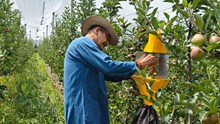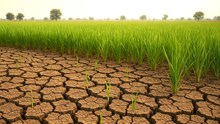
For any farmer, soil is the most valuable resource. Yet across India—from hills to plains—this precious topsoil is being lost to rain, wind, and human activities. Erosion not only lowers agricultural productivity but also pollutes nearby water bodies through sedimentation and harms the broader environment. Traditional erosion control methods like manual seeding or laying grass mats often fail under extreme weather or on steep slopes.
This is where hydroseeding offers a compelling solution. Originally developed for construction and infrastructure projects, hydroseeding is now gaining traction in agriculture, especially in erosion-prone regions. By spraying a slurry of seeds, mulch, fertilizer, and water, it forms a nutrient-rich, protective cover that anchors the soil and supports rapid plant growth. For farmers, it blends science, sustainability, and cost-effectiveness into a practical method for land restoration.
What is Hydroseeding and How Does It Work?
Hydroseeding is a process where a dense, green slurry of seeds, mulch, fertilizers, water, and occasionally binding agents is sprayed onto the ground surface through specially designed machines. The slurry clings to the ground and creates a moist, protective cover that retains moisture, suppresses erosion, and helps seeds germinate rapidly.
Prior to applying hydroseeding, land managers or farmers ready the land by weeding, grading the land if necessary, and providing good drainage. After applying the mixture, it behaves as a natural blanket that wraps around the ground, aids in root growth, and results in a dense vegetative cover in weeks.
Heart of the Mix: Seeds, Mulch, and Nutrients
Seed selection is the most important part of the process. Farmers need to select those seeds that are appropriate to the local climate, soil type, and proposed use. In the Himalayan foothills of North-Eastern states, local grasses that tolerate cold and grow on slopes are preferred. In Rajasthan or Karnataka dry regions, drought-resistant types are selected. Salt-tolerant grasses are employed in the Southern coastal belt.
The slurry mulch is made from wood fiber, straw, or recycled paper and acts like a sponge. It retains water, keeps the soil moist, and forms a micro-environment that accelerates seed germination. Fertilizers added give the seeds much-needed nutrients such as nitrogen and potassium, while unique natural binders or tackifiers cause the blend to cling to the ground even in slopes or rain.
How It Is Applied: Art and Science of Spraying
Hydroseeding is generally carried out in a hydroseeder machine. The machines contain mixing tanks in which all the materials are mixed and agitated together to create a homogenous slurry. This slurry is sprayed through the use of hoses or nozzles based on the region. In high hillsides or highway banks, high-pressure spray guns are employed to shoot far and wide.
For smaller farms or terrace fields, portable forms of these machines or manual pumps are employed. The reason this technique is particularly valuable is that it traverses uneven terrain uniformly, extending to cracks and slopes where manual seeding would not be very effective.
Rapid Growth and Soil Stability
After being sprayed, the layer of mulch starts working right away. It shades out the seeds from the sun and birds, retains moisture, and reduces water run-off. Within a week or so, farmers can see small sprouts, and within two to three weeks, there is a green cover. When the roots penetrate deeper into the soil, they bind soil particles together, so they cannot be washed away by rains.
This is especially beneficial for areas with landslide susceptibility or flash flooding, such as Uttarakhand, Sikkim, and some parts of Assam and Meghalaya. For Maharashtra's Western Ghats or Kerala's hill regions, hydroseeding can assist in re-claiming landslide-risky fields. Even for urban agriculture or roadside farming initiatives, it aids in forming durable green covers on embankments.
Economic Benefits for Indian Farmers
For marginal and small farmers, economics plays a central role. Even though hydroseeding equipment may be costly, community-based ownership or assistance from government watershed and soil conservation programs makes it feasible.
Hydroseeding costs much less per acre compared to turf-laying or manual sowing followed by repeated watering. After establishment, vegetation also minimizes irrigation requirements by enhancing soil's water-holding capacity.
Hydroseeding minimizes the frequency of replanting and weed management, reducing labor expenses. It is even possible to produce fodder grasses using this technique, which is of immense importance in rainfed situations where there is limited pasture. Hydroseeding can generate income for livestock in areas such as Bundelkhand or Vidarbha.
Real-life Applications: Thailand and Railway Projects
Internationally, hydroseeding has been employed successfully by the Highway Authority of Thailand to stabilize roadside slopes with large inclines and to avoid erosion. Indian instances cover application by FCE Railways, with hydroseeding employed to establish vegetative covers on disturbed ground adjacent to railway tracks and bridges.
The above examples prove that the method is tested, reliable, and scalable even under Indian conditions. Awareness and training for local farmers and agriculture officers are now needed to implement it on a larger scale.
Caring for the Green Cover: Maintenance Tips
Following spraying, normal watering for the initial 10–15 days guarantees germination success. Farmers should not walk over the newly hydro seeded ground and should stay cattle away until the grass is fully grown. Weeding, gap filling, and further spraying might be necessary depending on soil type and rainfall. The cover becomes self-perpetuating with little care after a couple of months.
Hydroseeding offers Indian farmers a sustainable way to rejuvenate their land, blending traditional knowledge with modern technology. With proper training and support, it can become a vital tool in soil conservation, transforming fragile terrains into thriving ecosystems—helping secure both their livelihoods and the environment, one spray at a time.
















